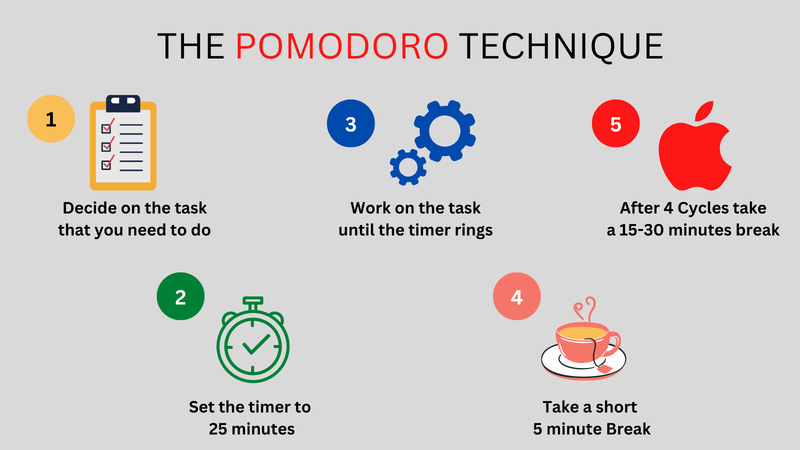
In the quest for enhanced productivity and improved focus, the Pomodoro Technique stands as a beacon of efficiency. This time management method, developed by Francesco Cirillo in the late 1980s, has garnered widespread acclaim for its simplicity and effectiveness. In this comprehensive guide, we delve into the principles, benefits, and practical application of the Pomodoro Technique.
Understanding the Pomodoro Technique
At its core, the Pomodoro Technique is a time management approach that breaks work into intervals called “Pomodoros.” A Pomodoro typically consists of 25 minutes of focused work, followed by a short break of 5 minutes. After completing four Pomodoros, a more extended break of 15-30 minutes is taken.
Pomodoro Technique – Entrepreneur Francesco Cirillo developed Pomodoro
technique in this we break our task into span of time and take short break which is called pomodoro. Basic concept here is to work for a duration in which focus is
maximum so that person gets maximum out of available time.
Following steps are involved in pomodoro techniques.
1.Choose a task: Select the task you want to work on.
2. Set the timer: Set a timer for 25 minutes (one Pomodoro).
3. Work on the task: Focus solely on the chosen task until the timer rings, without any distractions.
4. Take a short break: When the timer goes off, take a short break of around 5
minutes. Use this time to relax and recharge. Try not to use phone rather use
time so you can relax physically and mentally.
5. Repeat: After the break, start another Pomodoro (25 minutes) and continue the cycle.
6. Long break: After completing four Pomodoros (four 25-minute work sessions),take a longer break of around 15-30 minutes.
Principles of the Pomodoro Technique
1. Focus on Short Bursts:
The Pomodoro Technique operates on the principle that the human brain functions optimally within concentrated, short bursts of activity. By breaking work into manageable intervals, typically 25 minutes in duration (known as Pomodoros), individuals can tap into the brain’s ability to engage deeply with tasks without succumbing to mental fatigue. Research in cognitive psychology supports this notion, indicating that sustained attention and focus tend to decline after a certain period, commonly referred to as the “attention residue” effect.
The 25-minute interval aligns with the brain’s capacity for sustained attention and concentration. It’s a timeframe that allows individuals to dedicate their full focus to a task without feeling overwhelmed or losing interest. Leveraging this concept of intense, concentrated effort within short bursts aids in maintaining motivation and engagement while optimizing productivity.
2. Eliminate Distractions:
During each Pomodoro, the emphasis lies in minimizing distractions to create an environment conducive to deep work. Distractions, whether they come in the form of emails, notifications, or interruptions, hinder productivity by disrupting the flow of concentration. The Pomodoro Technique advocates for creating a distraction-free zone during the 25-minute intervals, allowing individuals to immerse themselves fully in the task at hand.
By eliminating distractions, individuals can harness their cognitive resources more effectively, resulting in higher-quality work output within the designated Pomodoro timeframe. This deliberate focus on eliminating external disruptions aligns with the principle of optimizing attention and mental energy towards the task, thus enhancing overall productivity.
3. Breaks for Refreshment:
Intertwined with the focus on short bursts of work are the regular short breaks integrated into the Pomodoro Technique. These brief breaks, typically 5 minutes in duration, serve as vital moments for mental refreshment and rejuvenation. While sustained focus is essential, prolonged periods of continuous work can lead to mental fatigue and diminishing returns in productivity.
The short breaks between Pomodoros act as opportunities to recharge and maintain mental agility. Engaging in activities like stretching, walking, or simply stepping away from the work area allows the mind to rest and reset. These moments of respite prevent burnout, enhance creativity, and enable individuals to return to the next Pomodoro with renewed energy and focus.
4. Iterative Work Cycles:
The Pomodoro Technique operates on a cyclical pattern, alternating between focused work intervals (Pomodoros) and brief breaks. This iterative structure creates a rhythm that promotes sustained productivity while accommodating the need for adaptability and adjustments.
The repetition of Pomodoros followed by short breaks forms a structured work cycle that helps individuals maintain momentum and rhythm throughout the day. The iterative nature of the technique allows for adaptability, enabling individuals to reassess their progress, make necessary adjustments, and recalibrate their approach as needed. This iterative work cycle is designed not only to enhance productivity but also to foster a sense of flow and rhythm in task completion.
Implementing the Pomodoro Technique
Step 1: Preparation
Select a Task: Choose a task or project to work on.
Set a Timer: Set a timer for 25 minutes—the traditional Pomodoro duration.
Focus Solely on the Task: Work on the selected task without interruptions until the timer rings.
Step 2: Break
Take a Short Break: After completing a Pomodoro, take a 5-minute break to rest and recharge.
Refresh the Mind: Engage in activities like stretching, walking, or simply relaxing to rejuvenate.
Step 3: Repeat and Adjust
Repeat Pomodoros: Continue this cycle of 25 minutes of focused work followed by a 5-minute break. After four Pomodoros, take a more extended break of 15-30 minutes.
Adapt to Needs: Adjust the duration of Pomodoros and breaks as needed to suit individual preferences and tasks.
Benefits of the Pomodoro Technique
1. Enhanced Focus and Concentration:
The structured intervals enhance focus, allowing individuals to dive deep into tasks without succumbing to distractions.
2. Increased Productivity:
The method encourages a sense of urgency and helps in completing tasks more efficiently by breaking them into manageable segments.
3. Time Awareness and Tracking:
The Pomodoro Technique fosters awareness of time spent on specific tasks, aiding in better time estimation and task management.
4. Reduced Procrastination:
The approach combats procrastination by creating a sense of commitment to work during each Pomodoro.
Overcoming Challenges with the Pomodoro Technique
1. Task Interruptions:
Address interruptions by setting boundaries and communicating the Pomodoro schedule to colleagues or family members.
2. Task Compatibility:
Some tasks may not align perfectly with a 25-minute Pomodoro. Adapt the technique by modifying Pomodoro durations as needed.
3. Mental Fatigue:
If mental fatigue sets in during a Pomodoro, consider shorter breaks or engaging in light physical activities to refresh the mind.
Integrating the Pomodoro Technique into Daily Life
Work Environment Optimization:
Create a Distraction-free Zone: Designate a workspace conducive to focused work, minimizing external distractions.
Utilize Tools: Use timers or Pomodoro-specific apps to track intervals and breaks efficiently.
Task Prioritization:
Task prioritization is at the core of effective time management, especially when employing the Pomodoro Technique. This method emphasizes breaking down tasks into smaller, manageable segments and prioritizing them to make the most of focused work intervals (Pomodoros).
Planning Tasks in Manageable Segments:
Breaking down tasks into smaller, more manageable segments is pivotal for aligning them with the time frames of Pomodoros. Complex or lengthy tasks can often seem overwhelming when approached as a whole. However, by dividing them into smaller chunks, individuals can make significant progress within a 25-minute Pomodoro.
This segmentation process involves dissecting larger tasks into actionable steps that can be completed within a single Pomodoro. For instance, instead of aiming to “write a report,” the task could be broken down into smaller segments such as “outline report structure,” “research data for section 1,” or “write introduction paragraph.” Each of these segments is small enough to be completed within a Pomodoro, allowing for a sense of accomplishment and progress.
Prioritizing Tasks for Pomodoros:
Once tasks are broken down into manageable segments, the next step is to prioritize them based on importance and urgency. Not all tasks are created equal, and some carry more weight in contributing to overall goals or deadlines. The Pomodoro Technique encourages individuals to tackle high-priority tasks during Pomodoros to optimize productivity.
Prioritization helps in determining which tasks should be addressed first during the focused work intervals. Tasks can be categorized using methods like the Eisenhower Matrix, which distinguishes tasks as urgent, important, non-urgent, or non-important. High-priority tasks that are both urgent and important should take precedence during Pomodoros to ensure they receive the required attention and focus.
Maximizing Productivity with Task Prioritization:
Task prioritization aligns with the core principles of the Pomodoro Technique, enhancing productivity by ensuring that the most crucial and impactful tasks are addressed during the focused work intervals. By breaking tasks into manageable segments and prioritizing them, individuals can maintain a clear direction and focus during Pomodoros, thus maximizing their effectiveness.
This approach not only aids in completing tasks efficiently but also provides a sense of accomplishment as smaller segments are checked off the list. Additionally, addressing high-priority tasks during Pomodoros ensures that valuable time and energy are dedicated to activities that contribute most significantly to overall goals and outcomes.
Task prioritization within the framework of the Pomodoro Technique is a strategic approach to managing time effectively and maximizing productivity. By breaking tasks into manageable segments and prioritizing them based on importance and urgency, individuals can make significant strides in accomplishing their goals within focused work intervals. This methodical approach ensures that time is allocated efficiently to tasks that yield the greatest impact, leading to enhanced productivity and a greater sense of achievement.
Advanced Strategies with the Pomodoro Technique
Pomodoro Extensions:
Embracing Pomodoro extensions involves experimenting with altered intervals to cater to different task demands. One notable extension is the ‘Double Pomodoro,’ where the standard 25-minute work interval extends to 50 minutes, followed by a 10-minute break. This extension is beneficial for longer, more intricate tasks that require sustained focus without overwhelming mental fatigue.
The ‘Double Pomodoro’ provides an extended block of time for deep concentration while maintaining the essence of the Pomodoro Technique – intermittent breaks to refresh and recharge. This adaptation allows individuals to delve deeper into complex tasks, fostering a balance between prolonged focus and necessary recuperation.
Task Review:
After completing a Pomodoro cycle, taking a brief moment to review progress and make necessary adjustments is a strategic practice. Task review involves evaluating the work completed during the Pomodoro – assessing accomplishments, identifying challenges encountered, and refining strategies for subsequent cycles.
This reflective pause facilitates continuous improvement by allowing individuals to refine their approach. It provides an opportunity to celebrate achievements, address obstacles faced, and make proactive adjustments to enhance productivity in the next cycle. Task review promotes a growth-oriented mindset, enabling individuals to adapt their methods for better efficiency and effectiveness.
Advanced strategies within the Pomodoro Technique, such as Pomodoro extensions and task review, elevate its application beyond standard intervals and breaks. Experimenting with extended work intervals like the ‘Double Pomodoro’ caters to the demands of more complex tasks, balancing sustained focus with adequate rest. Meanwhile, incorporating task reviews fosters a culture of continual improvement, allowing for adaptive strategies and refined productivity in subsequent cycles. These advanced techniques empower individuals to tailor their approach, optimizing productivity and efficiency in diverse work scenarios.
The Pomodoro Technique stands as a dynamic tool for enhancing focus, productivity, and time management. Its principles of segmented work, focused intervals, and strategic breaks offer a structured yet adaptable approach to task completion. By leveraging its strategies—be it through task segmentation, prioritization, or advanced variations like extensions and reviews—individuals can harness their productivity while preserving mental freshness. The Pomodoro Technique isn’t just about managing time; it’s a philosophy that empowers individuals to work smarter, achieve more, and find a harmonious balance between intense focus and rejuvenating breaks in their daily pursuits.
admin
Related Posts
A Comprehensive Overview of Psychological Testing
A Comprehensive Overview of Psychological Testing Psychological testing is a broad set of instruments and methods used to assess many elements of a person’s mental

Understanding the importance of SEO – Geeta University
Understanding the importance of SEO – Geeta University In today’s digital age, it’s necessary for businesses to create a strong online presence. With more and

Content Marketing : A contemporary Manual-Geeta University
Content Marketing : A contemporary Manual – Geeta University Content marketing is an essential tool for any business or organization that wants to build a


